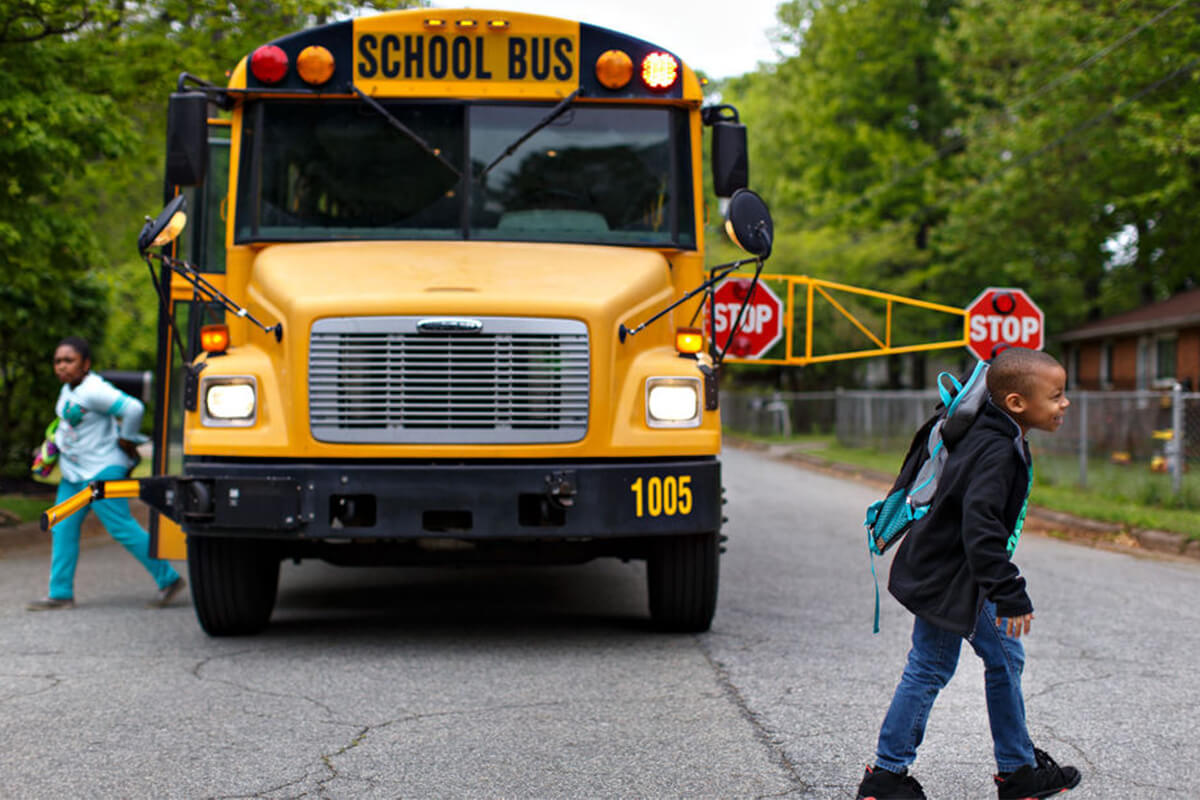
October 20, 2022
School buses are an integral part of the public school system and an essential mode of transportation to consider for road safety. In the 2018-19 school year, school buses were responsible for transporting 57% of the 21,115,737 K-12 public school students daily (National Center for Education Statistics, 2020). Between 2010 and 2020, 72 students were killed in school bus loading and unloading zones (Kansas State Department of Education, 2021). Approximately 63% of these fatalities were due to being struck by other vehicles while a bus was loading or unloading students (Kansas State Department of Education, 2021). Alarmingly, these statistics do not include injuries and near misses, making the true danger of school bus unloading and loading zones difficult to assess.
One method used to prevent injuries and fatalities around school buses during loading and unloading is the inclusion of a stop-arm with red flashing lights. The stop-arm is a stop sign that extends from the left side of the bus and is accompanied by red flashing lights anytime a school bus is loading or unloading passengers. In the U.S., passing a school bus while the stop-arm is extended is illegal (National Highway Traffic Safety Administration, n.d.). Despite the laws, motorists still illegally pass school buses while their stop-arm is out. In 2019, a one-day observation survey across 39 states and DC recorded 95,494 illegal passings of school buses while loading and unloading students (National Association of State Directors of Pupil Transportation Services, 2019). The extreme number of violations is likely an underestimation, as previous work shows bus drivers are likely to underestimate the number of vehicles illegally passing during a stop (Katz et al., 2021). The illegal passing of school buses is a clear problem that needs to be addressed.
To address the problem of stop-arm violations, automated surveillance devices can be used to record vehicle information of illegally passing vehicles for later citations. Automated traffic safety surveillance devices, such as red-light and speed cameras, have been shown to improve the overall safety of roadways where they are deployed (Cohn et al., 2020; Tilahun, 2022). Like red-light cameras, automated school bus violation-capture systems may help reduce the number of illegal school bus passings and potential collisions.
In 2007, VTTI spearheaded some of the earliest research on using automated cameras to reduce illegal school bus passing (Hanowski et al., 2007). The primary objective of this early work was to develop a prototype device that could automatically detect and record the license plate and driver image from vehicles illegally passing a stopped school bus. Through a series of trials, VTTI tested the two iterations of a five-camera system equipped with infrared pulse sources across various potential real-world scenarios. Scenarios included different lighting conditions, different locations of illegally passing vehicles, different speeds of illegally passing vehicles, and different weather conditions. In the end, the technology at the time of the publication was not quite at the level it would need for real-world deployment, but the lessons learned were invaluable. VTTI’s research helped lay the foundation for future work on automated citation devices for school buses. VTTI illustrated the importance of partnerships between law enforcement, legislative representatives, and schools for the potential success of programs geared toward child safety.
VTTI made another significant effort regarding school bus safety in 2010 with a synthesis report supported by the Federal Motor Carrier Safety Administration. As part of the report, the research team pulled together a group of experts in pupil transportation and identified the most critical perceived threats to student safety from environmental, organizational, technological, and driver domains. Among the hazards identified, the illegal passing of school buses by other vehicles, inattention of other drivers, and potential driver distractions were identified by experts as the greatest threats to pupil safety. The experts identified stronger enforcement of violations, improved driver training, and increased funding for improving pupil transportation safety.
Cohn, E. G., Kakar, S., Perkins, C., Steinbach, R., & Edwards, P. (2020). Red light camera interventions for reducing traffic violations and traffic crashes: A systematic review. Campbell Systematic Reviews, 16(2), e1091. https://doi.org/10.1002/CL2.1091.
Hanowski, R. J., Spaulding, J. M., Gaskins, C., Schaudt, W. A., Miller, S., Holbrook, T., Olson, R. L., Dingus, T. A., Hickman, J. S., Huey, R., & Llaneras, E. E. (2007). Field Evaluation of Alternative Automated Systems for Reducing Illegal Passing of School Buses DTNH22-00-07007, Task Order 1 FINAL REPORT.
Kansas State Department of Education. (2021). National School Bus Loading & Unloading Survey Accumulative Data Report.
Katz, B., Kissner, E., Lee, D., Jackson, S., Raymond, P., & Rigdon, H. (2021). Examination of Three Districts Implementing Stop-Arm Camera Programs to Enforce Laws Against Illegal Passing of Stopped School Buses. https://doi.org/10.21949/1526001.
National Association of State Directors of Pupil Transportation Services. (2019). 2019 Survey on Illegal Passing of School Buses-Summary Results. https://nasdpts.org/stop-arm-violations.
National Center for Education Statistics. (2020). Digest of Education Statistics. https://nces.ed.gov/programs/digest/d21/tables/dt21_236.90.asp?current=yes
National Highway Traffic Safety Administration. (n.d.). Reducing the Illegal Passing of School Buses. Retrieved August 9, 2022, from https://www.nhtsa.gov/school-bus-safety/reducing-illegal-passing-school-buses.
Tilahun, N. (2022). Safety Impact of Automated Speed Camera Enforcement: Empirical Findings Based on Chicago’s Speed Cameras. https://doi.org/10.1177/03611981221104808.
Wiegand, D., Bowman, D., Hanowski, R., Daecher, C., & Bergoffen, G. (2010). Special Safety Concerns of the School Bus Industry. https://doi.org/10.13140/2.1.4485.0880.
This article was written by Brian Pugliese, Human Factors Transportation Researcher for the Division of Freight, Transit, & Heavy Vehicle Safety.